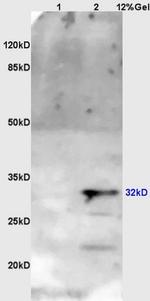Search Thermo Fisher Scientific
FIGURE: 1 / 1
OTX1 + OTX2 Antibody (BS-11958R) in WB

Product Details
BS-11958R
Species Reactivity
Host/Isotype
Class
Type
Immunogen
Conjugate
Form
Concentration
Purification
Storage buffer
Contains
Storage conditions
Shipping conditions
Target Information
Transcription factors, OTX1 and OTX2, are two murine homologs of the Drosophila orthodenticle (OTD), show a limited amino acid sequence divergence. OTX1 and OTX2 play an important role during early and later events required for proper brain development in that they are involved in the processes of induction, specification and regionalization of the brain. OTX1 is involved in corticogenesis, sensory organ development and pituitary functions, while OTX2 is necessary earlier in development, for the correct anterior neural plate specification and organization of the primitive streak. OTX2 is also required in the early specification of the neuroectoderm, which is destined to become the fore-midbrain, and both OTX1 and OTX2 co-operate in patterning the developing brain through a dosage-dependent mechanism. A molecular mechanism depending on a precise threshold of OTX proteins is necessary for the correct positioning of the isthmic region and for anterior brain patterning. The genes which encode OTX1 and OTX2 map to human chromosomes 2p13 and 14q21-q22, respectively.
For Research Use Only. Not for use in diagnostic procedures. Not for resale without express authorization.
References (0)
Bioinformatics
Protein Aliases: homeobox Otx2; Homeobox protein OTX1; Homeobox protein OTX2; Orthodenticle homolog 1; Orthodenticle homolog 2
Gene Aliases: A730044F23Rik; CPHD6; E130306E05Rik; jv; MCOPS5; Otx-1; OTX1; OTX1X; OTX2
UniProt ID: (Human) P32242, (Human) P32243, (Mouse) P80205, (Rat) Q63410
Entrez Gene ID: (Human) 5013, (Human) 5015, (Mouse) 18423, (Rat) 25646, (Rat) 305858, (Mouse) 18424

Performance Guarantee
If an Invitrogen™ antibody doesn't perform as described on our website or datasheet,we'll replace the product at no cost to you, or provide you with a credit for a future purchase.*
Learn more
We're here to help
Get expert recommendations for common problems or connect directly with an on staff expert for technical assistance related to applications, equipment and general product use.
Contact tech support
